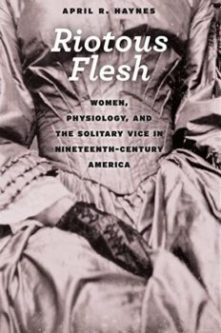Book Review: Riotous Flesh by April R. Haynes

April R. Haynes. Riotous Flesh: Women, Physiology, and the Solitary Vice in Nineteenth-Century America. Chicago: The University of Chicago Press, 2015.
When Sylvester Graham offered the same sex advice to women as men—no masturbation, which would cause insanity, disease, and death, and no sexual excess in marriage—riots ensued. His 1833 “Lecture to Mothers” treated women’s passion as equal to men’s and instructed women to take control of their bodies and sex lives. Mobs of men, including libertines, reacted in violence to these teachings throughout the decade, claiming to protect women from a quack, but in reality protecting their sexual privilege.
Moral reformers are usually remembered as for temperance and against prostitution, but Haynes demonstrates that they were also out to challenge the double standard of “male sexual privilege.” Women dubbed this “false delicacy” a term that became elastic over time. Thousands joined the female reform movement in order to challenge the fairly new (see Kerber and Lyons) definition of woman as weak and passionless so that they might take control of their bodies. This was “the first social movement led by women in United States history (10). But this desire to gain control of their own bodies and sex lives shifted entirely to policing others.
White, Protestant, middle-class women reformers responded by demanding the right to learn physiology, including women in the male-defined republican virtue (see Kerber), and limiting citizenship through virtue rather than gender. Women, rather than men, launched the first national anti-masturbation campaign.
African-Americans joined this reform group, which was also active in abolition. They noted a “false delicacy” in white men when it came to interracial sex, which caused race riots in 1834. The rioters had no problem with interracial sex so long as white men were in control. These women also rejected the white reformers ideal of virtuous female purity because it was associated with virginity, whiteness, fragility, and passiveness. Virtue without purity indicated responsibility, intention, and striving and transcended race and gender. Further, unlike purity, one could not lose her virtue through rape.
White women instead focused more on abolishing masturbation, and turned their advancement of the right to sexual pleasure to consumerism and activism. Interracial solidarity lapsed and white women began to police others’ sexuality. In the 1940s entrepreneur, Frederick Hollick, encouraged heterosexual (an anachronism, as gendered sex was not described or judged as such until the 1890s) sex for pleasure if within marriage (unlike Graham). Race science was used to depict black women as sexually excessive in both lectures and anatomy books, which furthered a white and pure definition of virtue which white women activists engaged.
Haynes also explores how an African American teacher, Sarah Mapps Douglass, resisted white definitions of healthy sex by teaching her Black students. She counseled on women’s healthy need for love and pleasure, challenged the popular and racist cranial science, and educated girls about contraception. Douglass redefined virtue for her students, including but not emphasizing warnings of the solitary vice.
Women’s reforms that promoted a healthy sexuality within marriage and warmed against masturbation eventually linked the “vice” to insanity. As moralism shifted to medicalization, physicians diagnosed “spermatorrhea,” the involuntary loss of semen due to masturbation, which reframed masturbation as a male problem in the public mind—women were so asexual as to be uninterested. By the 1860s, liberal feminists also considered feminine purity and sexual virtue one and the same, and African American women began to see this dominate their once-allies. Segregated sexual politics then became the norm, leading to the 1970s middle-class white feminists crusade for political liberation through masturbation, which did not take into account how absurd they seemed to Black and working-class feminists.
Fabulous book. Must read. (Disclosure: I almost studied with Haynes and that fantastic UWisc-Madison department but could not imagine myself living 4+ years in Wisconsin).
CATEGORIES: Women’s Sexuality/U.S. Social History, Sexuality Studies, Race, Female Masturbation, Health Reform, Women’s Rights, Intersectional Activism, Women’s Activism, 19th-Century U.S. History, Cultural History.
PLACE: United States
TIME PERIOD: 1830-1859
Was this useful? Keep us going with a quick tip. Thank you!
And buy stuff that you need from the links. Some of them send us kickbacks at no cost to you, but a wee cost to the empire. Thank you!